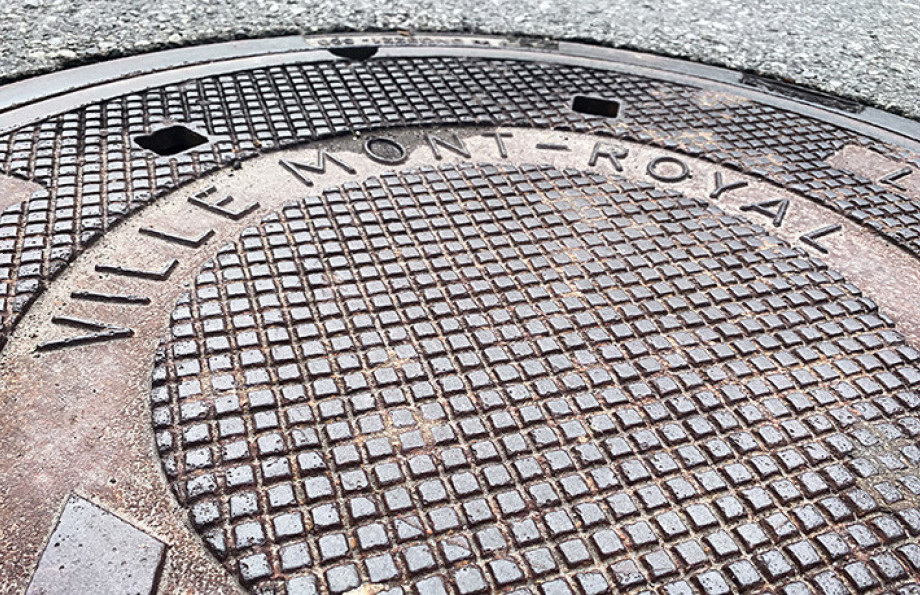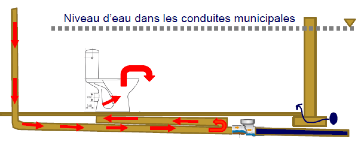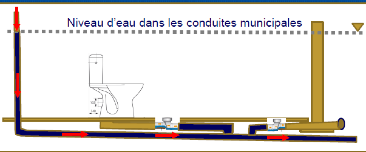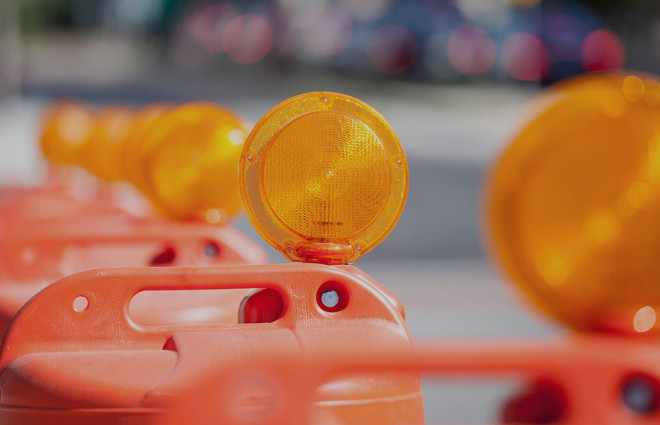Sewers and Water Mains

The Mount Royal public sewer and water mains networks each total 90 km of conducts. In the event of heavy rain, make sure your home is well protected by following the tips listed in our folder, available below.
Throughout the year, the Town carries out regular maintenance work on its sewer and drinking water systems. This work is carried out either by Public Works or by the Technical Services - Engineering division, depending on the availability of crews and the nature and scope of the work.
Action Plan Update - Sewers

Produced in 2024, the Stormwater Management Action Plan includes several activities and steps to improve and stabilize the performance of Town sewers.
The action plan presented on September 19, 2024 was divided into 3, namely:
- 2024-2025 - short term
- 2025-2026 - medium term
- 2027 and + - long term
Here's an update on the activities planned for 2024-2025 and a status for a few that are currently underway:
How to protect your home from heavy rain
September 25, 2024 - The recent heavy rains in our region have unfortunately affected many homes in our community. A public information evening on September 19, 2024, at Town Hall, has been held to learn more about the actions taken by the Town and to benefit from experts' advice on protecting your homes.
Climate-related disturbances are contributing to more frequent intense rain events. These extreme downpours send huge volumes of water into the sewer system over a very short period, overloading the system and leading to potential backflows. To help you protect your home, we've prepared a few tips and best practices that you can start adopting right away.
The sewer system
Most of the Town’s sewer system was designed in the 1950s. It is a combined system, meaning it manages both rainwater and wastewater. Water in the Town of Mount Royal’s sewer system is discharged into the system of the Urban Agglomeration of Montreal.
Today, no one municipal system on its own can manage these torrential rains, which have become commonplace. That is why it is important to take the right precautions by properly protecting your home and complying with municipal by-laws, particularly Chapter III of the Quebec Construction Code currently in force.
Many residents affected by water damage during an extreme weather event may wonder why neighbouring houses were spared from similar damage. Installing check valves on all secondary lines is an excellent start, but there’s more you can do. Rainwater flows from many sources, including your gutters, French drains, runoff from your property and the pavement.
Replacing your main sewer line is not the solution to your backflow problem.
First, conduct a proper inspection of all your plumbing infrastructure, taking into account the six (6) points listed in our folder. Don’t forget to have your check valves inspected and serviced regularly at least once (1) a year by a professional who is a member of the Corporation des maîtres mécaniciens en tuyauterie du Québec (Corporation of Master Pipe-Mechanics of Québec).
Check valves
Properly installing a check valve is one of the most effective ways of protecting your property against backflow. Check valves should never be installed to the property's main line, but to all secondary lines. What's more, each check valve must be kept in good working order, clean, accessible and properly installed.
Why install check valves on secondary lines and not on the main line?
Installing a check valve on your property's main line can lead to self-backflow.


Check valve maintenance - Not to be neglected
It's important to ensure that all your check valves are accessible at all times, to enable regular maintenance. If your check valve is located in a wall or under the basement floor, an access panel is required.
Maintenance should be carried out at least once a year. However, we suggest twice a year. A little tip to help you remember this important maintenance: remember to do it in the spring and/or fall, at the same time as the time changes. It's a great way to not forget!
IMPORTANT: Never open the check valve during backflow.
Here's a guide you can use with your professionals when it comes to check valve maintenance:
French drains or foundation drains
What are French drains/foundation drains?
A foundation drain is a perforated pipe buried around the footings of a building, designed to capture groundwater and carry it away from the house.
How can it cause water infiltration into your property?
If the drain doesn't drain properly, water can accumulate in the soil adjacent to the foundation, eventually seeping through cracks and causing seepage flooding. So it's important to make sure your foundations are watertight and free from cracks.
To better understand how water infiltration occurs, here's an explanatory video: https://www.youtube.com/watch?v=4uqRiGM5BPo
Gutters
Gutters that are directly connected to the foundation drain or to the main pipe that directs rainwater to an impervious surface, increase the amount of runoff that reaches the Town's combined sewer system and contribute significantly to system overload.
Disconnecting your gutters and properly landscaping your yard to accommodate this rainwater can divert an average of 100,000 liters of rainwater from the sewer system per year, per home.
Brochure : How can I protect my home from heavy rain?
Get tips on how to prevent sewer backup: consult our folder among the documents associated with this page.
In the event of a back-up, you have up to 15 days to submit a claim to the city if you believe the city is liable. Do so even before you know the extent of the damage and the associated costs.
Get tips on preventing sewer backup. See also the letterProtecting your home against water damage during extreme weather, updated in 2024.
Torrential rains of August 9, 2024
Following the heavy rains of August 9, TMR residents had many questions about flooding on the territory, which is why the Town of Mount Royal has prepared a document in which you will find answers to the most frequently asked questions on the subject. An information evening has also been held on September 19, 2024.
Sewer Back-Up Caused by a Problem With a Service Connection
In the case of obstructions caused by tree roots. Before contacting the Town, it is up to the homeowner to contract the services of a plumber to check his or her installations. A plumber can view the pipes with a camera to determine whether the problem is actually in the connection, either on the private or public side. Once the video has been received from your plumber, if you believe that the source of the problem is on the Town's side, it should be forwarded to Technical Services by e-mail at servicestechniques@ville.mont-royal.qc.ca.
In such cases, the municipality assumes responsibility for repairing the damage to the homeowner affected by the backflow. On the other hand, if the problem originates in the domestic network, which starts at the property line, the owner is notified.
Please make sure that your private system’s cleanout remains accessible at all times so it can be reached quickly in an emergency.
You have a window of fifteen days following a sewer back-up to submit a claim to the Town if you believe that the Town's responsibility is engaged. Do so before you even know the extent of the damage and the related costs.
Learn tips to protect your home against back-ups: consult the the folder in the documents associated to this page. See also the letterProtecting your home against water damage during extreme weather, updated in 2024.
Water Breaks
The aim of Public Works is to take charge of repair work within four to eight hours for water main break emergencies, from the time the break is reported.
The costs of repairs are assumed by Town of Mount Royal if the public system is found to be the source of the problem.
If the break is in a private line, the owner is given notice to have it repaired at his or her expense within a limited time.
Procedure – Application for Drinking Water or Sewer System Connections
All projects to connect to the municipal drinking water or sewer system, including modifications or disconnection of existing connections, require a permit issued by the Town of Mount Royal. This procedure details the steps to follow and documents to provide in compliance with the Water Supply By-law No. 1419 and the technical requirements of the Town and the City of Montreal regarding waste water and rainwater management (by-law no. 20-030 and Overflow management plan).
Work requiring a permit
A permit is required for, among other things, the following work:
- Installation of a new drinking water or sewer connection (new building);
- Replacement or repair of an existing connection;
- Change in the diameter of the water or sewer service on private land;
- Disconnection of connection shared with another property;
- Disconnection for a demolition (walling off or cut-off at source);
- Connection to a new rainwater management system;
- Any hooking up or modification on the public part of the property (road network).
Application steps
Coordination with the Urban Planning Department
To avoid delays in the processing of your application, the issuing of a connection permit should be coordinated with the issuing of a construction permit. It is therefore essential to provide the technical information at the start of the planning stage so the applications can be considered simultaneously. The applicant is responsible for ensuring that this coordination, if necessary, takes place.
File preparation
Preparing the plans, specifications, impermeable surfaces table, etc.
To reduce processing times, you should submit a complete and valid application. Any incomplete or invalid application will lengthen the waiting time for obtaining the required authorizations and entail additional work and costs for both you and the Town.
To obtain information about the plans and profiles of public water and sewer lines, submit an access-to-information request using the online form.
Submission of the application
The application should be submitted using the online form.
Technical analysis by Technical Services – Engineering Division
After receiving the online application, Technical Services will analyze the request.
Issuing of the permit, provided the project meets all the requirements.
Special requirements – drinking water connection for a new building
For all new building construction projects requiring a connection to the water main, the following documents should be included with the application:
- The drinking water consumption calculations (anticipated peak flow, simultaneity, etc.);
- A hydraulic simulation demonstrating that the proposed connection will not affect the minimum pressures required in the municipal system;
- The results of a pressure and flow validation in the sector concerned, either performed or approved by an engineer;
- If applicable, the proposed attenuation measures for any potential impacts identified (diameter adjustment, pressure boosting, etc.).
These requirements aim to preserve the integrity and performance of the Town’s water distribution system and ensure an adequate supply for all users.
Special requirements – rainwater management
A complete analysis is required if:
- The total impermeable surface of your property after completion of the work is greater than or equal to 1,000 m². The surface calculation must include all impermeable surfaces (new, existing and added, including the land and the structures on it), in compliance with the City of Montreal’s by-law no. 20-030.
- Storm sewer connections are planned.
- The proposed connections connect to the Montréal systems.
Surface category | Existing surface area (m²) | Planned surface area (m²) | Total post-work surface area (m²) |
Main roof | |||
Secondary roof/ covered balcony | |||
Asphalt or concrete parking area | |||
Walkway, driveway or access road | |||
Deck or patio (impermeable) | |||
Other (specify) | |||
Total |
Projects subject to a rainwater retention requirement also have to satisfy the following conditions:
- The stormwater balance between the existing condition and the planned condition is zero (with or without compensatory measures).
- For sectors where more than 50% of the surface area is impermeable, the following release thresholds apply:
- 10 L/s/ha for a 25-year peak rainfall event;
- 30 L/s/ha for a 100-year peak rainfall event.
- The anticipated discharge rate meets the most stringent of the following criteria:
- The above-mentioned rates;
- The City of Montreal’s requirements as specified in its by-law no. 20-030;
- The rates measured or calculated prior to the start of work.
- The drainage basins associated with the discharge points have been validated to determine the applicable discharge rate.
- All calculations are done by an engineer and comply with the City of Montreal’s by-law no. 20-030 and its revisions.
Required documents
Documents required for analyzing and issuing the permit
The permit application must include the following documents:
- A to scale layout plan that includes:
- Locations of the accesses, existing and proposed infrastructures (water supply and sewer), materials, lengths, slopes and diameters;
- Municipal hardware to be moved or replaced (streetlights, fire hydrants, etc.).
- Drainage system plans and specifications (signed and sealed by an engineer who is a member of the OIQ), which includes:
- Description of the system, materials, slopes, diameters, manholes and catch basins;
- Mechanical/Plumbing drawings (interior plumbing including the water meter installation details);
- Location/dimension of the connections, backflow preventers, roof drains and water meters;
- Sprinkler system (if required) and hydraulic calculations, signed and sealed by an engineer who is a member of the OIQ.
- All plans must be produced using a software package such as AutoCAD and be geo-referenced.
Additional documents required for rainwater management
Projects subject to a rainwater management analysis must provide the following documents:
- Impermeable surfaces table (pre- and post-project);
- Hydraulic calculations (projected flows, discharge rate, stormwater balance);
- Site drainage plan (including any retention/infiltration measures);
- Site landscaping plan;
- Diagrams for connecting to the municipal system;
- Summary table for each development phase and each connection point (if applicable);
- Data sheet for the proposed infrastructures (type, capacity, location, maintenance);
- PCSWMM modelling;
- Commitment to providing as-built plans once the work has been completed;
- Statement of compliance with municipal requirements (particularly regarding the discharge rate).
Statement on the scope of projects
Depending on the scope of the work and complexity of the project, the Town reserves the right to require additional documents and technical studies to ensure the connections comply with the current standards and the capacity of the municipal systems. This requirement may include, but is not limited to, detailed hydraulic studies, geotechnical validations and construction phasing plans.
Special notes
- Sanitary and storm sewer connection must be combined inside the building before being connected to the Town’s combined sewer system;
- For buildings with eight or more dwellings, the Town may require a manhole at the interconnection point (with a flow regulator, sealed watertight manhole cover, etc.);
- Detailed specifications will be provided by the Town after receipt of the complete application.
To get a permit for the installation of a new sewer and/or water main connection; please fill our online form.
Contacts
-
Public Works
Reception180 Clyde Road
Mount Royal, Quebec H3P 2N9 -
Engineering Division
Reception40 Roosevelt Avenue
Mount Royal, Quebec H3R 1Z4
Find relevant documents related to this web page



